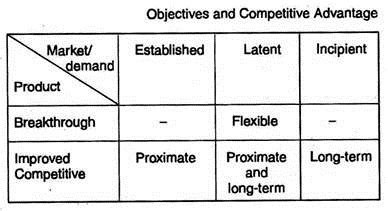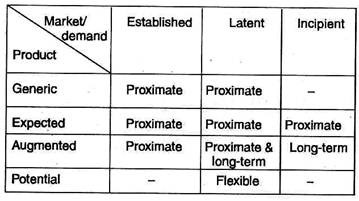The following points highlight the two major issues of product classification of a firm. The issues are: 1. Competing Products 2. Market/Demand Classification for Products.
Issue # 1. Competing Products:
They can be classified into one of three categories as follows:
(i) A breakthrough product:
This offers either a radical performance advantage over competition, a drastically lower price or, in a highly desirable but unlikely situation, it may offer both. Generally, such products are highly novel technology-based to meet the needs of the particular class of customers.
For illustration, the automobile was a breakthrough product in the 1890s, the radio in the 1920s, the television in the 1940s, the transistors in the 1950s and the computers in the 1960s.
(ii) A competitive product:
This does not provide clear-cut advantage over other products. It is considered competitive in the way that it is either a substitute for a basic product or it incorporates within it some substitute materials in order to match the performance characteristics as well as cost parameters.
Some of these are superior to competition, others are at a disadvantage. For example, synthetic fibres like dacron, nylon against cotton fibres; plastic moulded furniture against wooden furniture, etc.
(iii) An improved product:
This lies between the above two. It is not radically different but is considered superior to others in terms of either performance characteristics or competitive price or both. It is mostly the result of adaptation of advanced technology in the field to cater the needs of the particular market.
Issue # 2. Market/Demand Classification for Products:
We can make out the following classifications of market/demand according to their basic characteristics:
(i) Established market/demand:
It refers to the existence of a market where a particular customer need has been previously taken care of by the existing products, and where identical and new products can also play a role to meet customer needs.
(ii) Latent market/demand:
It refers to the situation of a market where the customers are aware of their needs and feel the necessity of certain products, but no products have so far been made available to them. These potential customers in the market are identified and served.
(iii) Incipient market/demand:
It refers to the situation of a market where the customers are unaware of their needs. So, a trend/point is required to be recognised and located wherefrom future customer needs will emerge and then only products will get customer acceptance.
The above characteristics call for new product innovation, development and marketing. So, cost of gaining customers acceptance is a factor to be reckoned with.
For existing market/demand, new product whenever launched has to prove its superiority in terms of use, quality, and serviceability or look over others available. When this superiority appears self-evident and lasting, the cost of customer acceptance is relatively low and competitive potential becomes correspondingly high.
For latent market/demand, the product is mostly novel and useful but its uses and services have to withstand the tests and trials of the prospective customers. Here, the product idea is important and needed to be sold rather than the product itself.
For this, product reliability and performance capability are needed to be properly demonstrated to ensure that it fits the customer’s needs. Above all, such products, for want of any other competitive products in the market, can be sold on cost-plus basis.
Under incipient market/demand, the products are highly radical by nature and characteristics and require innovative marketing skills and designs not only to find customers but to ‘educate’ them as well. The cost of gaining customer acceptance is the highest and it consists of cost of educating and cost of finding the customers.
Since no specific group of customers can be identified for such products, the uncertainty in the estimates of market size is compounded with the uncertainty of existence of the market.
The above classification of products and markets offers a means for examining the product-market scope for trends and directions which are competitively attractive and which also contribute to the firm’s objectives. From this examination, a firm can select an additional strategy component, called competitive advantage.
The table below is a good guide in this analysis:
An alternative approach from the standpoint of marketing opportunities can be as follows:
1. Generic product—that is, the basic product like a copper plate.
2. Expected product—that is, the product which is sought for by a customer in terms of specification, quality, reliability, price, etc.
3. Augmented product—that is, the product which is perceived to be of higher quality (that means, possessed of ‘value added’ characteristics) by the customers.
4. Potential product—that is, the product introduced now in the market but having future potentials.

